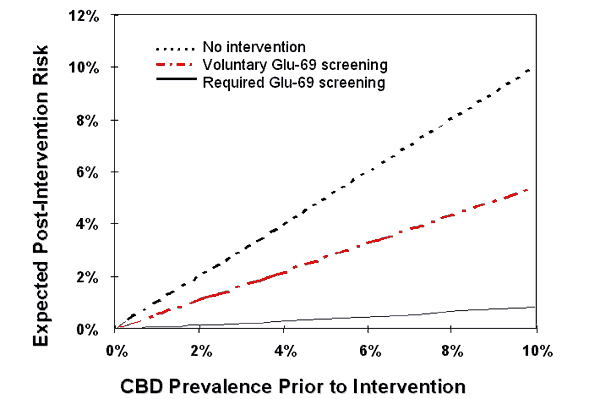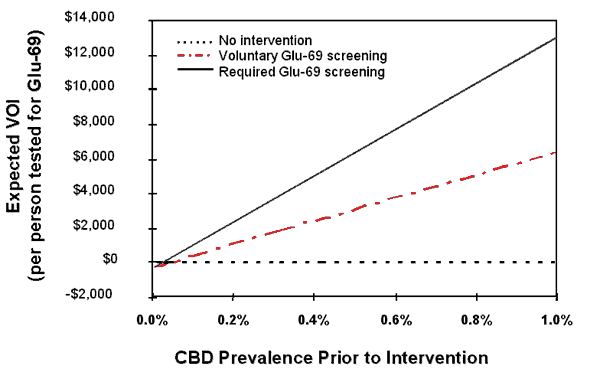Policy Analysis and Clinical Research on Occupational Beryllium Exposure at DOE Sites
R A PonceT K Takaro
S M Bartell
A J Jabbour
K Ertell
J Abbotts
S Barnhart
and E M Faustman
Worker Safety and CRESP and School of Public Health and Community Medicine, University of Washington, Seattle, WA
This research supported in part by CRESP through the Department of Energy Cooperative Agreement #DE-FC01-95EW55084. This support does not constitute endorsement of views expressed.
Introduction
The US Department of Energy has used beryllium in nuclear materials production, reactor rod fabrication, nuclear vessel cladding and many other uses since the 1940s. The industrial use of beryllium was found to result in an acute respiratory disease, acute beryllium disease, leading the Atomic Energy Commission to establish an airborne concentration standard of 2 µg/m3 for the workplace based on then accepted standards for other metals. Adoption of this standard has effectively eliminated the presence of acute beryllium disease. However, epidemiologic studies carried out during the 1980-90s has revealed the presence of another form of lung disease, chronic beryllium disease (CBD), among workers at US DOE sites.
In 1997, the Consortium for Risk Evaluation with Stakeholder Participation (CRESP) began a series of research efforts to investigate the prevalence of CBD among former beryllium workers at Hanford, evaluation of alternatives to the current screening tools for identifying pre-clinical disease, and policy implications of alternative occupational health program designs to reduce disease incidence among future beryllium workers, such as those involved in decontamination and decommissioning former beryllium facilities.
This poster describes the scope of CRESP beryllium research efforts and the implications of this research to beryllium workers at US DOE sites.
Laboratory Research on Chronic Beryllium Disease
CRESP investigators have selected several lines of research on chronic beryllium disease with direct relevance to occupational health program design, clinical diagnosis, and disease treatment. These are outlined below.
Investigating Chronic Beryllium Disease prevalence among former beryllium workers at Hanford. Since 1997, CRESP researchers have been conducting research to identify former Hanford workers who may have been exposed to beryllium at Hanford, and performing clinical testing to identify cases of beryllium sensitization or disease. Such research is crucial to the correct diagnosis of disease among these patients, and for developing appropriate treatment. Improved understanding of the baseline prevalence rate of this disease will also assist in developing improved occupational health programs at DOE to prevent among workers involved in future work in Hanford buildings with former beryllium use.
Developing improved clinical tests for detecting cases of sensitization to beryllium. Chronic beryllium disease (CBD) involves the on-going stimulation of the immune system in the lung by inhaled beryllium particles (see Figure 1). The clinical presentation of this disease is very similar to that of other lung diseases that involve this type of stimulation, which also occurs in tuberculosis, sarcoidosis and other lung diseases. A breakthrough in obtaining a specific test that correctly identifies CBD was the development of the Lymphocte Proliferation Test (LPT, see Figure 2). Although the current design of the LPT provides a relatively high sensitivity and specificity, inter-laboratory comparisons have shown discrepancies in test predictive value. Working in collaboration with researchers at National Jewish Hospital (Denver, CO), CRESP researchers are exploring the potential application of flow cytometry to improve this key clinical tool.
Investigating mechanisms of immune system activation and disease progression. Basic research investigating the cells involved in the immune response has shown that specific immune cells recognize beryllium and initiate the immune response that ultimately results in lung damage (see Step 1, Figure 1). This recognition involves the interaction of at least two cell types through proteins on their cell surfaces. Some individuals appear to have slight structural differences in these proteins that confers heightened recognition of beryllium and immune system activation (Figure 3). For these individuals, even minute exposures to beryllium can result in later disease. CRESP researchers are investigating the signaling mechanisms involved in immune system activation by beryllium, and in identifying the genetic factors that underlie beryllium hypersensitivity sensitivity.
CRESP Contributions to and Research on US DOE Occupational Beryllium Policies
CRESP has been actively involved in regional and national discussions on US DOE's beryllium occupational health policies. Examples of CRESP involvement include:
- Participation in the University of California Office of the President Workshop on the Control of Beryllium Disease in the Workplace (Berkeley, CA).
- Participation in the DOE Chronic Beryllium Disease Prevention Program Best Practices and Lessons Learned Workshop (Argonne National Laboratory).
- Participation in DOE Beryllium Health Risk Communication Task Force Workshop (Oak Ridge National Lab).
- Presentation of oral comments on DOE's proposed Chronic Beryllium Disease Prevention Program (Washington, DC) and submission of written comments on the proposed rulemaking.
CRESP has been actively engaged in analyses of alternative occupational health program designs for beryllium workers. Of great interest would be the potential use of susceptibility markers that could be used to inform workers about risk factors linked to increased sensitivity to beryllium (see Value-of-Information Analyses). CRESP has presented these results at national meetings (e.g., Society of Toxicology Annual Meeting, Society for Risk Analysis, SPECTRUM, American Nuclear Society), and the regionally-focussed "Health of the Hanford Site" meetings, to inform both the scientific audience and the community around Hanford regarding our research.
Figure 1: Beryllium-induced Immune Response in the Lung

- Immune cells in the lung recognize beryllium as a foreign particle, and initiate an immune response normally used to fight infection
- Activation of T-Helper cells in the lung lead to release of cytokines and other immune system activating substances in the lung. This activation leads to proliferation of immune cells, recruitment of other immune cells to the site of activation, and inflammation. Chronic activation can lead to permanent scarring of the lung and loss or respiratory capacity.
Figure 2: Beryllium Lymphocyte Proliferation Test

The lymphocyte proliferation test is the most sensitive method to test beryllium workers for the presence of pre-clinical disease. A positive result indicates that the individual's immune system is capable of reacting to beryllium and is at increased risk of developing disease with continued exposure.
Figure 3: Class II Major Histocompatibility Complex

Genetic analyses demonstrate regions of high variability in genes encoding for the receptors that play a primary role in recognizing beryllium and initiating the immune response. Epidemiologic studies have demonstrated some associations between specific genetic compositions for these genes and the risk of developing disease. One of the best candidate genes, DP-B1 is shown above. The regions depicted as 69 appears to have high predictive value in identifying individuals who may be at high risk of developing disease.
Figure 4: Policy Implications of Using Susceptibility Information in DOE Occupational Health Programs
Expected post-intervention CBD risk by risk management option and baseline CBD prevalence

Expected per capita VOI for Glu-69 by risk management option and baseline CBD prevalence

CRESP has explored the implications of using information on individual susceptibility to CBD across three alternative occupational health screening programs: no use of this susceptibility information (No intervention); voluntary genetic screening and self-selection out of future beryllium work if the test is positive (Voluntary Glu-69 screening); and mandatory screening with job replacement if the test is positive (Required Glu-69 screening). In the left graph, we present the expected disease prevalence that would occur across the three occupational health program designs across a range of baseline disease prevalence rates that are currently reported in the scientific literature (CBD is reported to occur in 1-5% of all beryllium workers, and in 10-15% of machinists and lappers). In the right graph, we present estimated cost per person tested across the three occupational health programs, and present results demonstrating very high savings from implementing the use of the genetic susceptibility information even when the baseline disease prevalence rates are less than 1% (which is the lower bound estimate of disease prevalence among all workers).
The results presented here demonstrate substantial clinical improvements and cost savings from using the currently available genetic information in occupational screening programs for beryllium. However, because of the serious social, legal, and ethical implications of using this information, we advocate the development of such screening programs only after broad social discussions regarding the ethical, legal and social implications of such screening programs.
What is Beryllium?
Material Properties
- Atomic weight = 9
- High tensile strength
- High heat capacity
- Excellent electrical conductivity
- High stiffness (modulus of elasticity)
- Neutron emitter when bombarded with ?-particles
Industrial Uses
- Gyroscopes, guidance systems, accelerometers
- Reactor rods (controls fission reactions when mixed with an ?-source)
- X-ray windows
- Spark-free tools (strengthens copper)
- Consumer products: Mountain bikes, electronics, ceramics, fishing rods, space shuttle/aviation, brakes
- [Fluorescent lights]
Significance of CRESP Research on Beryllium to US DOE
CRESP research on beryllium has taken two tracks: evaluation of DOE policies and medical research on chronic beryllium disease. The laboratory and field based clinical research effort promises to yield the research results that can be directly applied in clinical settings to 1) test beryllium workers for the presence of pre-clinical change, and 2) develop new treatment methods that interrupt immune system signaling pathways involved in disease progression. On-going epidemiologic studies to evaluate former Hanford workers promises to allow identification of former workers who have pre-clinical disease, and who should be monitored periodically to ensure that their disease does not progress without medical intervention. Such research can also be used to inform occupational health managers about the factors that contribute to disease onset and progression, with the hope that such information can be used to prevent future disease.
CRESP efforts to evaluate and influence DOE's Chronic Disease Prevention Program, their Beryllium Risk Communication program, site-specific occupational health policy development, and scientific database provides an academically-based and nationally focused perspective unique among other stakeholder in these deliberations. By design, CRESP's structure allows it to evaluate even the most controversial issues, including the clinical utility and economic value of using genetic susceptibility information in occupational health programs. (CRESP is currently examining the ethical, legal and social implications of such occupational health screening programs.)
Taken as a whole, CRESP's policy analysis and clinical research efforts on Chronic Beryllium Disease exemplify the strengths of a multi-disciplinary focus to examining pressing public health issues at US DOE sites.